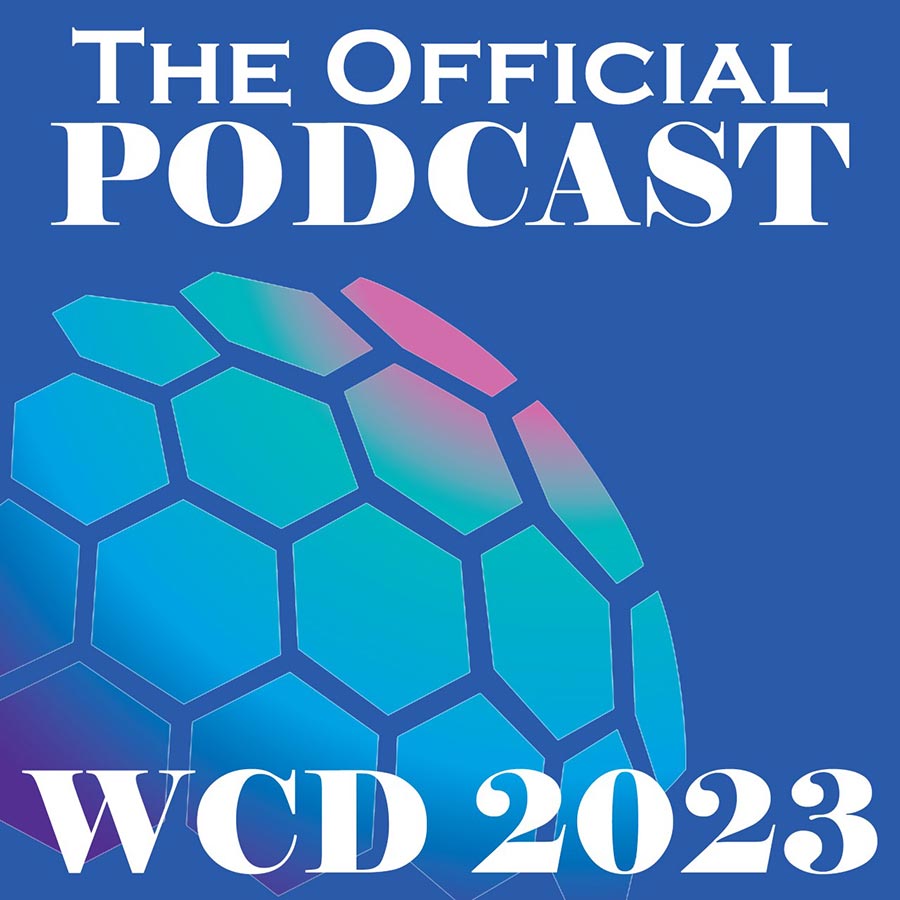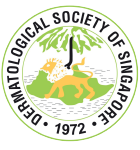From the Podcast of the 25th WCD
From the WCD Podcast

Episode 10 – Dr Etienne Wang (EW), National Skin Centre speaks with Dr Ellie Choi (EC), National University Hospital, and Prof. Dedee Murrell, St George Hospital, University of New South Wales.
(Transcript edited by E, EC, RC)
EW. Hi, welcome to the official podcast of the WCD, the is the World Congress of dermatology, which will be held next in Singapore in 2023. I am Dr. Etienne Wang from the National Skin Center of Singapore, and I will be your host for this podcast. You can listen to us on Apple podcasts, Spotify, PocketCast and wherever else to get your podcast. In this podcast, I’ll speak to dermatologists and skin researchers from all over the world to talk about all things dermatology. And today Ellie’s back with another very interesting topic.
EC. So, in the last episode I heard that Sashen talked about vision and the importance of visual acuity so I thought this week we could go along the same thread and talk about the sense of smell in dermatology.
EW. Okay! So the sense of smell is quite topical nowadays and a lot of people who get COVID lose the sense of smell, right? And apparently dogs have been able to pick up COVID from smell too, what in dermatology do you think smells different or distinct?
EC. Yeah, so, you know, when we think about what smells in dermatology, immediately things like chronic wounds or body odour that may be related to hyperhidrosis or infections of the skin that are associated with abnormal smells or odours, but if we take a step back and think about what actually is common in these conditions that lead to the smell, it’s actually most commonly secondary infections by bacteria or fungus. What happens is that these microorganisms, especially anaerobes, they breakdown substrates like carbohydrates, lipids, and amino acids, and in the process, they produce an array of volatile chemical molecules. So these molecules like thiols, hydrogen sulfide and putrescine that enters our nose and then results in the various forms of odours. Bacterial infections or fungal infections, they can be like primary, like abscesses carbuncles or in chronic wounds, like chronic lymphedema and elephantiasis or even things like pitted keratolysis with corynebacterial bacteria. And it’s also interesting to note that infections can occur secondarily in disorders like keratinization and acantholytic diseases, so like your ichthyosis, epidermolytic PPKs, Hailey-Hailey and Dariers disease. So it’s all these accumulation of macerated scales that allow the bacteria to proliferate and then release these compounds.
EW. Yeah. So what I’m hearing is that all these polyamines and volatile organic compounds might give us a certain kind of a signature to certain diseases and this might on top be modulated by the microbiome. Do you think human noses can tell the difference between these things?
EC. That’s a very good question. I am not particularly convinced that we have the ability to discern the scent of various odours, but it could also be because we’re not trained to do so. Certainly, in the literature, certain types of bacteria release a certain type of compounds that smell a bit different from other compounds, and it has been reported that, for example, pseudomonas has a particular grape like scent. But as to whether it would be discriminatory enough for us to use in clinical practice, that I’m not really sure.
EW. Well, I think that this is where AI and our manufactured sensors might come in, right? Do you think that there could be a time when we could just wave something over a patient and be able to tell what kind of bacteria is living on a skin or the state of the microbiome and the state of inflammation just from the volatile compounds that are being released? Something like a robot nose?
EC. Yeah, actually, that is a very good point. I didn’t think about that, but I think you’re right. By right, all these sensors should be able to detect these volatile compounds and I do believe that technology should be advanced enough to differentiate one from another.
EW. Yeah, I think, to draw back that analogy to the visual thing that Sashen was talking about last time, we use things like the woods lamp and UV light to look at things that our human eyes can’t see so maybe a device to pick up these kinds of scents that we can’t detect ourselves might be able to help us make some interesting diagnoses in the future.
EC. Yeah correct, and apart from just diagnosing, I think knowing what organism is proliferating may also help us better target treatment because a lot of these secondary bacterial infections and odours can be quite troublesome to patients and can be quite distressing, so if we know what exactly is being released, it might help us to better reduce the odours that is associated.
EW. Or we could just get a dog to it.
EC. Yeah we could too [laughs]
EW. All right. Okay. Thank you. That’s some food for thought and I like it when you bring us something way out left field and I think it was a very interesting discussion. Thank you, Ellie!
And now let’s welcome Prof. Dedee Murrell (D) to the Podcast.

She’s a chair of the department of Dermatology to St.George Hospital, University of New South Wales in Sydney, Australia, and her main subspecialty interest and her current research focuses on the development and validation of clinical outcomes for EB and autoimmune blistering diseases. She’s also one of the esteemed Ambassadors for the WCD 2023. She is also the Executive Vice-President of the international Society of Dermatology from 2011 to 2013 and a chair of communications for the ISD from 2013 to 2017 and she will be the Congress President of the upcoming ICD 2021, which will be held in Melbourne, Australia.
Welcome Dedee to the Podcast!
DM. Thank you Etienne! I’m very excited to join the esteemed list of Ambassadors and Speakers of your conference and participants who will want to welcome everybody to the next World Congress of Dermatology in Singapore in 2023.
EW. Yes, but I think in a few weeks’ time, we will be having the International Congress of Dermatology, how is the preparations for that coming along?
DM. The preparations have been in the making now for eight years, after we bid for the conference in Delhi in 2013. We have John McGraw at the helm of our scientific committee and Rod Sinclair as my right-hand man and Greg Goodman in charge of cosmetic sessions, so how could we go wrong?
EW. Are there any highlights of the conference that you’d like to promote this time?
DM. Yes, we have four different themes for the conference. One of them is translational medicine, which is John’s forte: bringing bench to the bedside of what is relevant. Then we have global dermatology, which is looking at the burden of diseases throughout the world, including the more poverty-stricken areas in the world and problems that refugees suffer from. Then we have medical dermatology, and that’s my forte and then we have technological advances and, you know, the brand spanking new IT developments, particularly for visuals, for melanoma, etc. So it’s something for everyone!
EW. You’re also very interested in interchange of dermatology across countries. Can you tell me a bit about more of this passion of yours?
DM. My passion for international exchange began very young. I was fortunate to grow up in a family in England who loved to travel and so my parents took me all around Europe. In the summer holidays, when I was in a gap year situation, before I went to Cambridge, I got a scholarship to the United States and then I managed to engineer some electives in the Brigham and Women’s hospital in Boston, in Harvard Medical School. And so, by having the opportunity to then train as a dermatologist in the United States, gave me great insights into how healthcare is organized in another country. And since then, since I’ve qualified, I’ve made a point of trying to visit different colleagues, such as your wonderful Singapore Skin Center, places of work when I’ve gone to either holidays or conferences in other places. I think that we have something to learn from everywhere that we go and places that I’ve been to, that I would never have thought of in advance that I would learn so much. For example, Iran, when I visited hospitals in Teheran, in Razi hospital, it’s a huge skin hospital run by dermatologists where the surgeons are working for the dermatologists or the hospital at Shiraz, the university hospital there, where I was astonished to find the notes were being written in English, and the pemphigus patients who were admitted to a ward there, I was very impressed by how they insisted that the patients had a sterile gown put on every day and they had to have showers and this skin was covered in eosin, an old-fashioned compound which keeps your skin free from infection. Just basic things that you learn from going to another country which was very useful.
EW. Yeah. In Singapore also, for our dermatologists, until COVID, we all had overseas attachments and experiences that we are encouraged to apply for. But I think in the last couple of years, that has been…
DM. Curtailed…
EW. Yeah… And you’re also involved in the International Journal of Women’s Dermatology. Is that something that’s also shares a theme with your passion for helping people from disadvantage groups and countries?
DM. Yes. I’m one of the co-founding editors of the IJWD, along with Jane Grant-Kels, who’s now the deputy editor of the JAAD and our new co-editor is Jenny Murase for the last three years from California. And you are absolutely right, we had an agreement with the publisher Elsevier that people who were submitting articles, because it’s one of these new open access journals, peer reviewed, but unfortunately with that model, people have to pay once their peer reviews have been accepted. And there is funding for that in some countries, particularly in Europe but not so much in Australia and the United States so, from poor countries whom we are keen to hear from them, there were waivers from some countries Africa, India, Iran. And so we had quite a lot of submissions from these countries on the topics that we were interested in. It was to encourage publications from these places.
EW. That’s very, very encouraging. And you alluded to this earlier, but you were our HMDP visiting expert in 2018 to Singapore. What memories you have of our little red dot country?
DM. I loved coming to Singapore! Apart from the fact that I think I surprised you in one of my lectures that I had purchased my wedding dress in Orchard Road in Singapore, so it was quite entertaining for everybody to see that! I heard so much about the NSC from all the trainees from Australia, whom one of them has the opportunity to come and train with you every six months.
EW. Yes, we miss them very much.
DM. Yes! And when I was given my temporary office, I think on the fourth floor of your building and it said, Kenji Kabashima on the door and that impressed me a lot because I know Kenji and that he has been coming to your center for quite some time.
And I loved visiting all the subspecialty clinics, I loved interchanging with the residents. I was there, I think, during your exams and took part in the exams as well. And everyone was so friendly and invited me to the other hospitals in Singapore. And of course the standard is very very high in Singapore so, apart from everyone’s welcoming nature, it was a very memorable week to spend with you all.
EW. And we hope to see you again soon in 2023!
DM. Yes. This is what I’ve been saying. We were very much hoping that we could welcome all our international colleagues to our International Congress of Dermatology in about 30 days’ time in Melbourne. But Australia has had a huge lock down to protect its population from COVID and abruptly the conference had to be virtual, but thanks to our enterprise we’ve got this unique TV style Dermathon, 24 hours a day meeting so that you won’t turn on from the United States or Europe or wherever you happen to be in and find a blank screen. There will always be something down in channels to entertain you. And we are proposing that people who would have liked to come to Australia, come to your conference in 2023 and plan well ahead because Singapore is about a hop, step and a jump from Australia and you can get here easily on a direct flight. You can go to beautiful Queensland where the barrier reef is, you can go to Crocodile Dundee country in Darwin, or you can go to Perth, Western Australia, and these flights around are only about four hours so that’s less than crossing the United States or crossing Europe, so we look forward to welcoming you after Singapore 2023.
EW. I think our Ambassadors are all trained very well to give all of these travel advertisements.
DM. I mean, seeing Singapore is lovely, but after a few days, it is a relatively small place and they might want to expand the horizons!
EW. Speaking about COVID, there is one more thing I wanted to ask you about: in July 2020, you submitted a letter to the dermatology therapy about music therapy reducing the burden of dermatological diseases. I really enjoyed that letter. Can you tell us more about how this letter came about?
DM. You know, there is an interesting doctor called Mohamad Goldust from Iran and he’s now working in Switzerland and he put together some interesting teams of people to write articles together during COVID when I think some of the clinics were closed down, and I think it was his idea to gather papers and experiences together about this, and I know that some of the experts were a bit reluctant to join this team because they thought this topic was a little too far. But I remembered patients in the hospital when they can’t communicate or they’re cut off from other people, for whatever reasons, such as having an infectious disease, that if you can hear music, that means something to you, that your relatives can send to you, you might be terminally ill and it will make you calm down, and then interestingly, during the year after we published this paper, one of our palliative care specialists was giving medical grand rounds on that very topic of the terminally ill and how to take care of them and what the impact of COVID have had on them and he also talked about the impact of music on calming people. So, whilst I was feeling a little bit nervous about being part of a publication on this topic, I am glad to see that someone has read it!
EW. I’m a huge passion for music so I like to see papers like that now and then!
DM. I remember hearing you entertain us at the dinner and at the closing dinner of the Conference! I remember you were singing!
EW. Yes, I was! All right, so thank you for joining me on this podcast. Good luck for the ICD and I really hope to see you in Singapore in 2023!
DM. I will be there! I look forward to seeing you again Etienne! Thank you very much. Take care, bye!
EW. That was the official podcast of the WCD. Don’t forget to follow us on all our socials on Facebook, Instagram at WCD 2023 Singapore and check out our WCD website, WCD 2023singapore.org, for more updates and content on WCD.
And until next time, stay safe and use sunblock!














